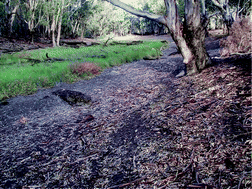Analytical approaches to the determination of simple biophenols in forest trees such as Acer (maple), Betula (birch), Coniferus, Eucalyptus, Juniperus (cedar), Picea (spruce) and Quercus (oak)
Abstract
Analytical methods are reviewed for the determination of simple biophenols in forest trees such as Acer
(maple), Betula
(birch), Coniferus, Eucalyptus, Juniperus
(cedar), Picea
(spruce) and Quercus
(oak). Data are limited but nevertheless clearly establish the critical importance of sample preparation and pre-treatment in the analysis. For example, drying methods invariably reduce the recovery of biophenols and this is illustrated by data for birch leaves where flavonoid glycosides were determined as 12.3 ± 0.44 mg g−1 in fresh leaves but 9.7 ± 0.35 mg g−1 in air-dried samples (data expressed as dry weight). Diverse sample handling procedures have been employed for recovery of biophenols. The range of biophenols and diversity of sample types precludes general procedural recommendations. Caution is necessary in selecting appropriate procedures as the high reactivity of these compounds complicates their analysis. Moreover, our experience suggests that their reactivity is very dependent on the


 Please wait while we load your content...
Please wait while we load your content...